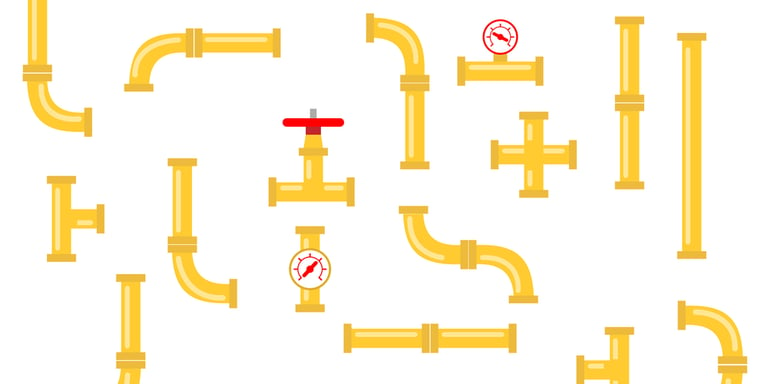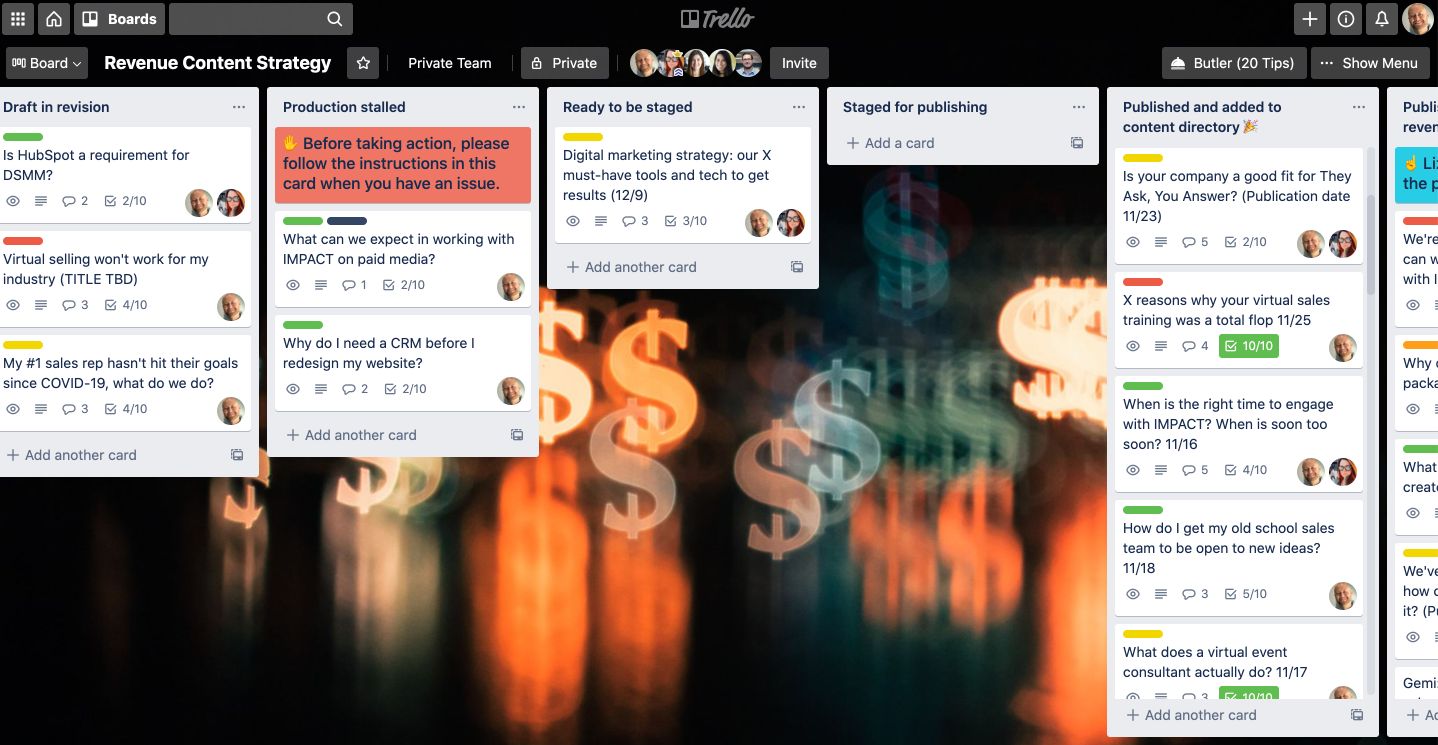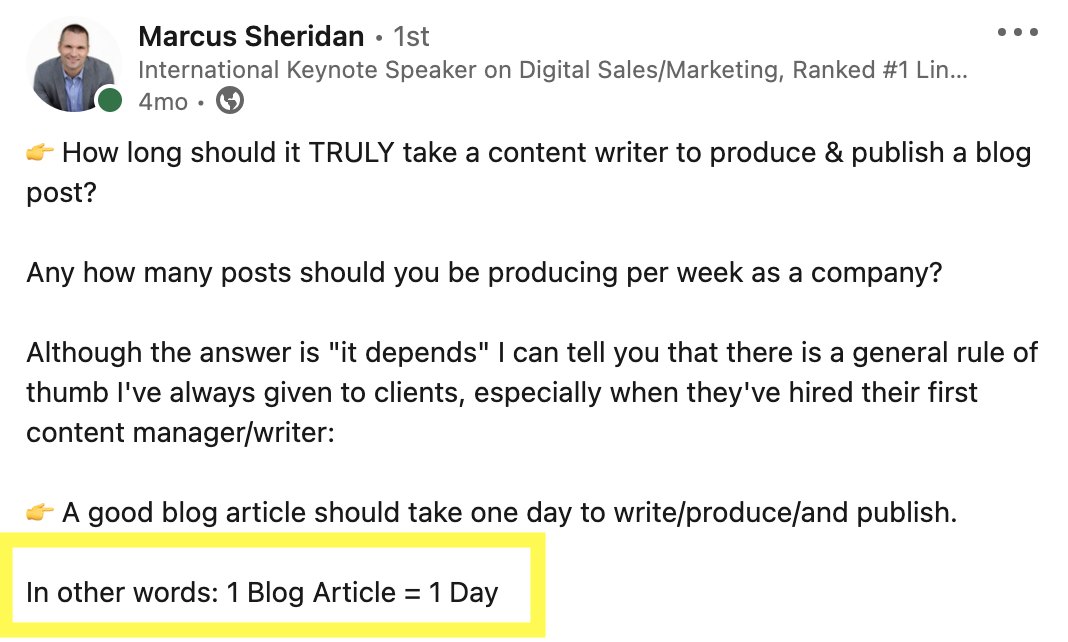Subscribe now and get the latest podcast releases delivered straight to your inbox.
Christine Clone Test; Inbound marketing success: Building a healthy content pipeline (Clone)

By John Becker
Sep 10, 2021

Most new content managers suffer from two conflicting, gut-wrenching anxieties:
- Oh my goodness, I’m going to run out of content ideas within the next few days!
- Oh my goodness, there’s no way I’m ever going to be able to write all the content we need!
Strangely, these tend to alternate instead of balancing each other out.
Sometimes you feel like you’re scraping the bottom of the barrel and you’re going to write yourself out of a job. (No content needs means no content manager.)
At other times, you’re facing a sky-high mountain of content needs and you can only type so fast. (*Nervously cracks knuckles.*)
Luckily enough, the solution to both of these worries is the same: You need to build a stable, consistent process to take each content idea from brainstorm to publication.
If you’ve always got a backlog and an easy way to track progress, you’ll squash these fears and get back to worrying about things that really matter, like whether leftover Halloween candy is still OK to eat.
I mean, that peanut butter cup is sealed, so…
A steady content pipeline is vital to They Ask, You Answer success
At IMPACT, we’ve helped thousands of businesses succeed with our They Ask, You Answer framework that simplifies content marketing and delivers results.
And They Ask, You Answer is neither gimmick nor trick: It takes steady effort to succeed, and a central contributor to the entire initiative is the content manager.
Indeed, for most successful They Ask, You Answer companies, the hiring of a content manager is a watershed event. Often, they try at first to have someone else on their team handle content, but when a person wears too many hats, something slips. When it comes to content, that means fewer articles going out, as well as diminished quality.
But with a dedicated content manager on staff, a company has a full-time writer who can crank out content, interview SMEs, write scripts, edit website copy, and more.
At the center of a content manager’s responsibilities, though, is the regular publication of quality content that directly addresses customer questions.
What does a healthy content pipeline look like?
As a content manager, you’re sort of like a one-person content factory: You’re likely responsible for each piece of content, end-to-end.
As you produce each piece of content, though, you should always have several other content projects in process. Seeing a single piece of content all the way through, from brainstorm to publication, one at a time, is too inefficient. Real-world content production involves a good deal of waiting (some voluntary, some not), and your time is best divided among tasks.
A content manager should always have a whole bunch of irons in the fire. A few pieces that are done and ready to publish, more that are in various stages of the production process, and a healthy backlog of content ideas that are listed by priority.
Kevin Phillips, lead content trainer at IMPACT and all-around SEO and content marketing wizard, likes to tell his clients to have “nine in the pipeline.”
We advise our clients to publish three articles each week. So, if Kevin talks to a content manager on a Monday, they should have three already scheduled for this week, three nearly done for next week, and three more in earlier stages for the week after.
That way, they’re never scrambling to make a last-minute deadline. And, should something come up, publication won’t immediately suffer.
The 9 steps of content production
Think of it this way, all content more or less follows the same steps, from brainstorm to publication. For me, these steps look like this:
- Brainstorm the idea
- Write an outline or interview questions
- Conduct research or interview
- Draft the article
- Edit
- Get approval
- Stage
- Final check
- Publication
*Note: Sometimes pieces can move backward in this process, or ping-pong between steps. There might be a few rounds of editing and approval, for example.
The efficient content manager should always have numerous articles in every stage of this process, including a healthy backlog of topics that have been brainstormed but not started.
Right now, as I write this, I’ve got two articles staged and scheduled, and three more in the final stages of revision. I’m working on four (with three more interviews scheduled for the next few days), and I have a backlog of 18.

How long does a piece of content take to create?
Writing at a steady clip of three articles a week should keep you pretty busy. Content expert Marcus Sheridan, author of They Ask, You Answer, says each article should take about a day to produce. In other words, about eight hours.

I took Marcus’s general principle and wanted to see how it applied to real life.
For a recent piece of content I wrote and published, I tracked all of the time I spent, from initial idea to final product.
Now, this was a longer article — a 2,400-word step-by-step inbound strategy explanation. All told, I spend exactly three hours and 11 minutes writing and editing the document — about two and a half hours writing and 45 minutes editing. (I can track all of this with a Chrome add-on called Draftback.)
Start-to-finish in just over 5 hours
So, how did I spend my time when working on this piece? I tracked that, too. Although there are some estimates, these are generally hard numbers.
Below are the normal steps of my content creation process, in order, and I’ve added explanations about how much time I spent at each stage.
- Brainstorm idea. This topic was assigned to me by our director of content, so I didn’t spend any time brainstorming. 0 minutes.
- Write an outline or interview questions. I pretty quickly knew the direction I wanted to go with this piece. I put down an initial structure that I tweaked slightly as I wrote it. It took me about 20 minutes.
- Conduct research or interview. This one was a bit tricky. I did initial research before starting, and then more as I went. The research was blended into the writing process. But I’ll estimate 50 minutes.
- Drafting. Actually writing the article took me about two and a half hours. Again, this was a longer piece, and this included some research along the way. I’m also pretty ADD, so I’m sure I was checking Slack and doing other things during the writing process. Still, I’ll say 150 minutes.
- Editing. The next day, I spent time editing — and then I did the same two days later. Altogether, I spent about 45 minutes editing.
- Get approval. I sent a draft to Kevin Phillips for his feedback. It took him some time, but it didn’t take me any time, other than sending him a message. Thus, zero minutes getting approval. 0 minutes.
- Staging. Once the draft was ready, I staged it in HubSpot. This always takes longer than I think it will, especially with extra images that I need to resize, title, and insert. 40 minutes.
- Final check. Paul, our director of content, does a final check on everything before it goes out. So, 0 minutes of my time.
- Publication. Ditto.
All in all, for the work I did, it looked like this:
What delays content?
So, if an article takes less than a day to produce, why can’t it get out the door more quickly? Well, two main reasons:
- A content manager has other tasks to do (meetings, mostly) that slow things down.
- Content spends a lot of time sitting around before it gets out the door.
The truth is that the longest part of content production is idle time. There’s the actual work of writing the article (as detailed above), and there are the times in between, when a piece of content sits on a virtual desk, waiting for the next step to happen.
If a single piece of content takes less than eight hours to produce, it probably takes two or three weeks to publish. Here’s what that process looks like:
- Brainstorm idea — There’s always time between a brainstorming session and getting started. For me, the idea needs to develop in the back of my head. (+1 day)
- Once I have an idea where the piece will go, I can write an outline or interview questions. I need to do this before I schedule an interview so the SME knows what to expect. I never like to schedule an interview on the next day, so I try for later in the week. Then, I send a one-on-one video going over the questions and the piece as a whole. (+3-5 days)
- Conduct research or interview. An interview is quick (usually about 20 minutes), but then I pay to have it transcribed (auto-transcriptions from Rev.com are a cheap and quick option). Then I go through the transcript and pull out relevant quotes and snippets. If I’m doing research, I spend time reviewing sources, looking through statistics, and more. But this is not idle time.
- Once I’ve done all that, I can start to draft. The more work I’ve done on the front end, the easier this process is. Funnily enough, the writing usually doesn’t take all that long.
- Hemingway famously said that “the first draft of anything is shit.” That’s pretty good advice, so you need to spend time editing, whether you do that yourself or work with a colleague. If you do it yourself, you should wait for a while so you can look at the piece with fresh eyes. If you share it with someone else, you’ll need to wait for them to get it back to you. (+1 day)
- Once you’ve cleaned up your draft, you can send it back to the SME or anyone else for approval. They need a chance to look it over to make sure your facts are right. (+2 days)
- With an edited and approved draft in hand, you can move forward to stage (or get it into your publishing system) your piece. Sounds fun, sounds easy, but actually, it takes a really long time. Double-check your links, write your meta description, resize your images, craft your URL, standardize spacing and headers, and you’re ready for your ...
- Final check. Whether it’s you or a colleague, someone will have to go through one last time — nice and slow — to check everything. Same as the editing above. If it’s you, wait a day. If it’s someone else, it will depend on their schedule. (+1 day)
- You’re ready to hit “Publish”! But, more likely, you’re ready to hit “Schedule for later” because the articles being published today were written and staged last week. Once something is totally good to go, it can sit for days (sometimes longer) to actually get out the door. If you just publish things as soon as they’re ready, you’re less likely to have a consistent publication schedule. (+3-5 days)
Adding it all up
This single piece of content took me a little more than five hours to produce, start to finish. It also spent about 12 days hanging around, waiting to move forward. That’s (*checks calculator*) about 96 hours.
Or, to put it another way:
Organization is everything
To succeed as a content manager, you have to constantly move things forward. There are parts of the process you control (writing, editing, etc.), but there are parts you don’t. A chunk of your time will go to touching base and following up with people, helping to free those articles that have gotten snagged on their journey down the content river.
Organization is vital.
Kevin recommends a few different tools to keep everything running smoothly. Something as simple as a Google spreadsheet can suffice, especially for organizations on a smaller scale. Bigger companies can use project management tools such as Trello, Basecamp, ClickUp, or an equivalent.
These allow collaboration and documentation as each project moves forward. Without a system in place, things slip between the cracks or get unintentionally put on the back-burner.
Build your content factory
Henry Ford revolutionized the modern factory by introducing the assembly line. Before this change, a team of workers would build a car from start to finish. One team, one car at a time.
With the assembly line, though, the car itself would move forward, with each worker performing the same task on each car that came in front of him.
With this new system in place, Ford was able to reduce the time it took to build a single car from 12 hours to one hour and 33 minutes.
You need to be your own little content factory. Build a process that lets you put your effort where it’s needed so that there are numerous pieces of content on the assembly line at any given time. By the time one rolls off the line (and is published), there’s already another ready to take its place.
Keep nine in the pipeline and you’ll always be in good shape.


Order Your Copy of Marcus Sheridan's New Book — Endless Customers!